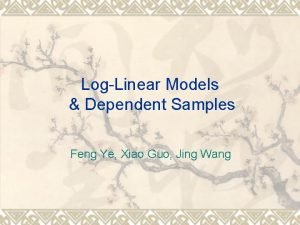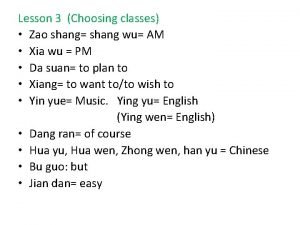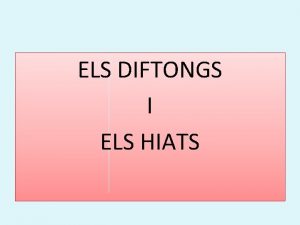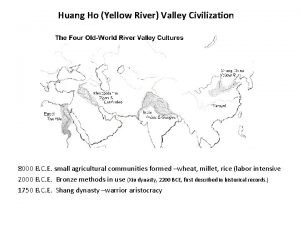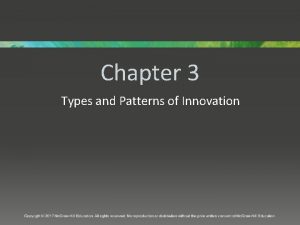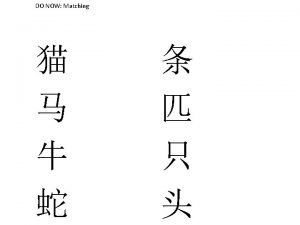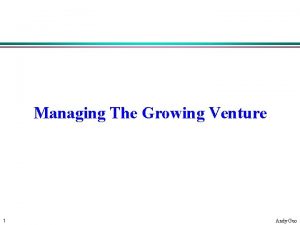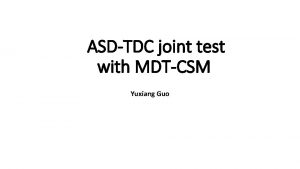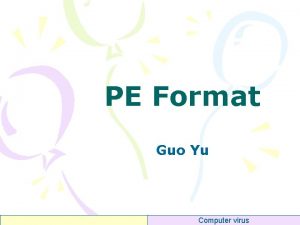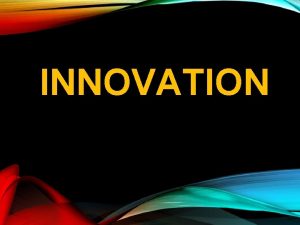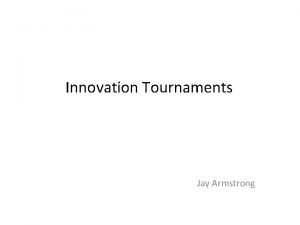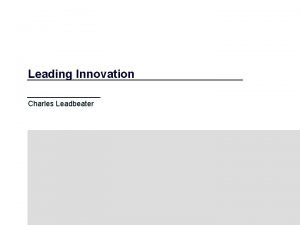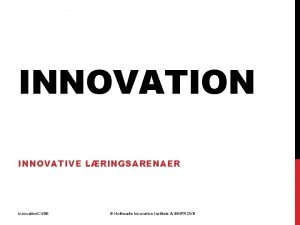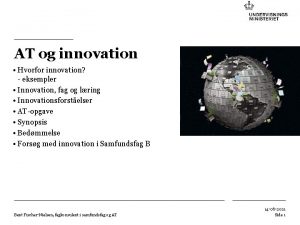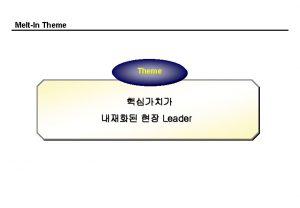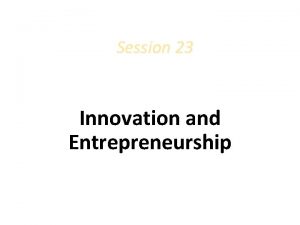Types of Innovation 1 Andy Guo Outline l




























- Slides: 28

Types of Innovation 1 Andy Guo

Outline ü l l l 2 Types of innovation Product versus process innovation Incremental, radical, modular, architectural innovation Sustaining versus disruptive innovation Andy Guo

Product versus Process Innovation l Product innovations are embodied in the outputs of an organization – its goods or services. l Process innovations are innovations in the way an organization conducts its business, such as in techniques of producing or marketing goods or services. l Product innovations can enable process innovations and vice versa. l What is a product innovation for one organization might be a process innovation for another w E. g. , UPS creates a new distribution service (product innovation) that enables its customers to distribute their goods more widely or more easily (process innovation) 3 Andy Guo

Incremental versus Radical Innovation l Incremental innovations may involve only a minor change from (or adjustment to) existing practices. l The radicalness of an innovation is the degree to which it is new and different from previously existing products and processes. l The radicalness of an innovation is relative; it may change over time or with respect to different observers. w E. g. , digital photography is a more radical innovation for Kodak than for Sony. 4 Andy Guo

Modular versus Architectural Innovation l Modular innovations entail changes to one or more components of a product system without significantly affecting the overall design. w E. g. , adding gel-filled material to a bicycle seat l Architectural innovations entail changing the overall design of the system or the way components interact. w E. g. , transition from high-wheel bicycle to safety bicycle. l Most architectural innovations require changes in the underlying components also. 5 Andy Guo

Sustaining versus Disruptive Innovation l Sustaining innovations build on the firm’s existing knowledge base w E. g. , Intel’s Pentium 4 built on the technology for Pentium III. l Disruptive innovations renders a firm’s existing competencies obsolete. w E. g. , electronic calculators rendered Keuffel & Esser’s slide rule expertise obsolete. l Whether an innovation is sustaining or disruptive depends on the perspective of a particular firm. 6 Andy Guo

Outline l ü l l 7 Types of innovation Product versus process innovation Incremental, radical, modular, architectural innovation Sustaining versus disruptive innovation Andy Guo

Patterns of Industrial Innovation Rate of Major Innovation Product Innovation Process Innovation Fluid Pattern 8 Transitional Pattern Specific Pattern Andy Guo

Emergence of Dominant Designs 9 Andy Guo

Dominant Designs in Six Industries 10 Andy Guo

Number of Firms in Six Industries 11 Andy Guo

Why Dominant Designs Are Selected? l Increasing returns to adoption w When a technology becomes more valuable the more it is adopted. Two primary sources are learning effects and network externalities. w The Learning Curve: As a technology is used, producers learn to make it more efficient and effective. 12 Andy Guo

Why Dominant Designs Are Selected? l Prior learning and absorptive capacity w A firm’s prior experience influences its ability to recognize and utilize new information. § Use of a particular technology builds knowledge base about that technology. § The knowledge base helps firms use and improve the technology § Suggests that technologies adopted earlier than others are likely to become better developed, making it difficult for other technologies to catch up. 13 Andy Guo

Why Dominant Designs Are Selected? l Network Externalities w In markets with network externalities, the benefit from using a good increases with the number of other users of the same good. w Network externalities are common in industries that are physically networked § E. g. , railroads, telecommunications w Network externalities also arise when compatibility or complementary goods are important § E. g. , Many people choose to use Windows in order to maximize the number of people their files are compatible with, and the range of software applications they can use. 14 Andy Guo

Why Dominant Designs Are Selected? l 15 A technology with a large installed base attracts developers of complementary goods; a technology with a wide range of complementary goods attracts users, increasing the installed base. A self-reinforcing cycle ensues: Andy Guo

Why Dominant Designs Are Selected? l Government Regulation w Sometimes the consumer welfare benefits of having a single dominant design prompts government organizations to intervene, imposing a standard. § E. g. , the NTSC color standard in television broadcasting in the U. S. ; the general standard for mobile communications (GSM) in the European Union. l The Result: Winner-Take-All Markets w Natural monopolies § Firms supporting winning technologies earn huge rewards; others may be locked out. 16 Andy Guo

Why Dominant Designs Are Selected? l Increasing returns indicate that technology trajectories are characterized by path dependency: w End results depend greatly on the events that took place leading up to the outcome. l. A dominant design can have far-reaching influence; it shapes future technological inquiry in the area. l Winner-take-all markets can have very different competitive dynamics than other markets. w Technologically superior products do not always win. w Such markets require different firm strategies for success than markets with less pressure for a single dominant design. 17 Andy Guo

Outline l l ü l 18 Types of innovation Product versus process innovation Incremental, radical, modular, architectural innovation Sustaining versus disruptive innovation Andy Guo

Incremental, Radical, Modular, Architectural innovation l Incremental innovation w Large, electrically powered fans, mounted in the ceiling, with the motor hidden from view and insulated to dampen the noise l Radical innovation w A move to central air condition l Modular innovation w The replacement of analog with digital telephones l Architectural innovation w Introduction of a portable fan 19 Andy Guo

A Framework for Defining Innovation Core concepts Reinforced Overturned Unchanged Incremental innovation Modular innovation Changed Architectural innovation Radical innovation Linkage between core concepts and components 20 Andy Guo

Example: Bike 21 Incremental innovation Modular innovation Architectural innovation Radical innovation Andy Guo

Example: Camera 22 Incremental innovation Modular innovation Architectural innovation Radical innovation Andy Guo

Outline l l l ü 23 Types of innovation Product versus process innovation Incremental, radical, modular, architectural innovation Sustaining versus disruptive innovation Andy Guo

Disk-Drive Performance History 24 Andy Guo

Technology & Market Trajectories Product Performance improvement required by mainstream market Expected trajectory of Performance improvement Current performance of potentially disruptive technology Time Source: Christensen (1999) 25 Andy Guo

Markets and Disruptive Technology Product Performance Technology improvement High-end markets Mainstream markets Low-end markets Established technology Disruptive technology Time 26 Andy Guo

Different Technologies Product Performance improvement required by mainstream market Expected trajectory of Performance improvement Current performance of potentially disruptive technology Time 27 Andy Guo

28 Phase 3: Competition based on convenience Price Phase 2: Competition based on reliability Convenience Phase 1: Competition based on capacity Reliability Capacity Evolution of Competition Phase 4: Competition based on price Andy Guo
 Mysite socccd
Mysite socccd Radical innovation vs disruptive innovation
Radical innovation vs disruptive innovation Lixiong guo
Lixiong guo Xiaoli guo larsén
Xiaoli guo larsén Feng guo symmetry
Feng guo symmetry Shang wu hao
Shang wu hao Cai guo qiang footprints of history
Cai guo qiang footprints of history Tongfei guo
Tongfei guo Que son els hiats
Que son els hiats Siyao guo
Siyao guo Xiang jiao ping guo
Xiang jiao ping guo Kajal chokshi
Kajal chokshi Dr minh mai
Dr minh mai Chuanxiong guo
Chuanxiong guo Practical path guiding
Practical path guiding Jiafeng guo
Jiafeng guo Huang ho valley
Huang ho valley Sujian guo
Sujian guo Sujian guo
Sujian guo Guodong guo
Guodong guo Sentence outline example
Sentence outline example Strategy innovation and entrepreneurship
Strategy innovation and entrepreneurship Types and patterns of innovation
Types and patterns of innovation What is the name of the island tamal tells andy about
What is the name of the island tamal tells andy about Andy kampfschulte
Andy kampfschulte Txdot class c concrete
Txdot class c concrete Andy woods the coming kingdom
Andy woods the coming kingdom Andy woods daniel
Andy woods daniel Dr andy woods age
Dr andy woods age




